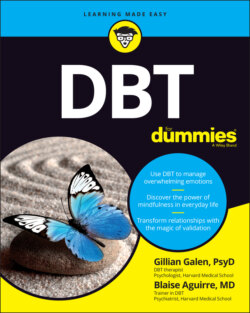Читать книгу DBT For Dummies - Gillian Galen - Страница 42
Moving from contradiction to synthesis
ОглавлениеFor people who enter DBT, life is much more complicated than being stuck in traffic jams. Often intense emotions lead people who are struggling to behave in self-destructive ways, and self-injury like cutting is a very common behavior in people who have intense emotions. Many people, when seeing self-injurious behavior, would say, “Cutting yourself is a serious problem!” However, people who cut don’t always see this as a problem. Instead, they see self-injury as a solution to the problem of intense emotions. So, the behavior is both a problem and a solution? This appears to be a contradiction. From a dialectical perspective, however, both positions are true.
The synthesis is that people who have intense emotions that lead to significant psychological suffering want the suffering to end, and that self-injury is a quick way to solve the problem of emotional suffering. People who self-injure have been found to have higher activity in the amygdala, the part of the brain that experiences emotions, in response to emotional images. Higher activity in the amygdala is associated with a feeling of distress. Although for many people, self-injury would increase amygdalar activity, paradoxically, in people who for whom self-injury is regulating, there is a reduction in amygdalar activity, and this in turn leads to a reduction in negative mood and an increase in positive mood.
And yet self-injury is only a short-term solution that doesn’t solve the problem of long-term emotional distress. When we move the focus from the self-injury to the problem being intense emotions, we develop a new perspective on the various points of view as having validity. The contradiction has become a new way of seeing things through the synthesis of seeing the perspective of each.
Another seeming contradiction is that DBT therapists hold the assumption that in the absence of other information, a person is doing the best they can. The contradictory position that the therapists also hold in mind is that a person in DBT can do better. So, how can a person be doing the best they can, and also be able to do better? Here the contradiction is explained by the consideration that if a person is incapable of managing intense emotions, either because they don’t have the skills to do so or because they are flooded by the magnitude of the emotional storm under those circumstances, then it’s the best that they can do. The synthesis between the two positions is that the person is doing the best they can in the moment and needs to try harder and be more motivated to change.
An analogy would be to consider that a person has just learned how to swim. They get into a shallow pool and paddle around just fine. If they are then taken to a stormy ocean with big waves and thrown in, they have great difficulty managing the situation. Given that they are a beginning swimmer, it’s the best that they can do. However, our swimmer must learn how to manage more difficult swimming conditions if they ever want to leave the shallow pool, and the way to do this is by learning the skills necessary to become a better swimmer.
For the emotionally flooded patient, their behavior at the moment of heightened emotion may be the best that they can do, and yet it’s also the case that they must do better if they want to live a life with less suffering. The way to do “better” is by learning new ways of coping when strong emotions threaten to overwhelm the mind. And so, the seeming contradiction that a person is doing the best they can and that they can do better coexist, and the synthesis is that the learning of new skills makes the person more capable of managing more complicated situations, whether intense emotions or swimming conditions. This is the nature of dialectics.
